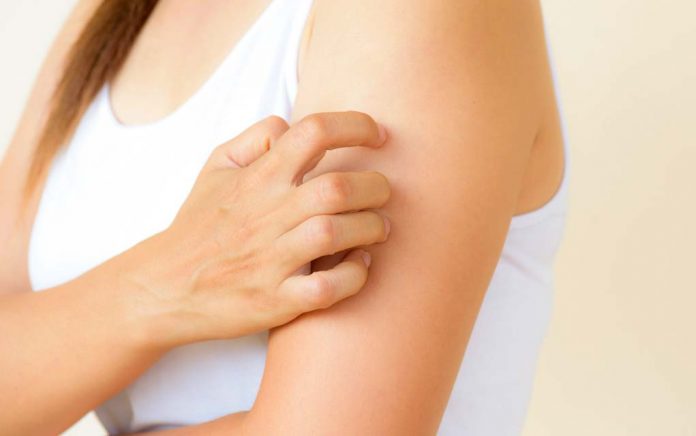
14 Natural Remedies for Hives
Recently my daughter had an allergic reaction to something she ate and broke out in hives. They appeared on her back and were raised, large welt-looking ovals. I immediately took her to a Medical Clinic and the doctor said they were definitely a reaction to something she came into contact with (possibly food or environmental), and I could give her an antihistamine to calm them down, or leave them be and they would go away on their own. We decided to leave them be and they disappeared by morning.
This incident got me thinking so I did some research. Hives typically appear suddenly and are brought on as an allergic reaction. The reaction involves the release of chemicals called histamines, which results in the eruption of welts, that may be small or large and individual or merged together. These welts can be extremely uncomfortable, especially for children who will find it difficult to resist scratching them and can risk infection if the scratching is excessive. Fortunately, hives often don’t last very long (most no longer than 24 hours) and generally are relatively harmless. For some people, however, hives are an indication of a life-threatening allergic reaction or they can be a chronic condition, lasting weeks or months.
What Can Cause Hives?
The appearance of hives can be the body’s natural response to any substance, taken orally or touched with the skin, it perceives as foreign or threatening. For some people, the substance can be a soap, fragrance, laundry detergent, certain fabrics, particular plants or bushes, alcohol, or specific foods or ingredients (e.g., tree nuts, shellfish, milk). In addition, stress, viruses (e.g., hepatitis B, Epstein-Barr, Candida albicans), excessive sweating, exposure to sunlight or extreme cold, interactions with pets or other animals, insect bites, and use of certain medications (e.g., antibiotic, nonsteroidal anti-inflammatory drugs) also can trigger the eruption of hives.
Hives can appear anywhere on the body, including the face, trunk, and private parts. If you’re not sure the eruptions are hives, press the center of the raised wheal and if it turns white, you have hives.
Natural Antihistamine for Hives
Before we talk about ways to treat hives naturally, it’s important to know that if the hives are mild, practicing a little patience may be all that’s necessary, as they will likely go away on their own. In the meantime, you should avoid hot showers or baths and tight-fitting clothing as well as any substances that may irritate them, such as soaps, detergents, and body products. However, if you want to facilitate their disappearance and/or if the hives are less than mild, here are some natural remedies.
Natural Remedies for Hives
Acupuncture. In cases of chronic hives, acupuncture can be an effective complementary remedy. Use of acupuncture may not only provide immediate relief from itching but also help attack the root of the problem. In a recent scientific article, the authors noted that Chinese medicine (including acupuncture) “has been shown to relieve symptoms and prevent recurrence” of chronic urticaria, but that there is a “lack of robust evidence from the evidence-based medicine perspective” thus far.
Baking soda. A paste composed of baking soda (1 teaspoon) and cold water can not only calm existing hives but also help prevent new ones from occurring. After applying the baking soda paste to the hives, allow it to dry completely before washing it off with a soft cloth and cool water. You can use this remedy several times a day.
Read about the healing powers of baking soda
Cold compresses. Just like heat can exacerbate hives, cold and even cool compresses can calm the itching and inflammation. A cold wash cloth applied to the affected area, as well as a cool/cold bath or shower can be helpful.
Fish oil. For now there is limited scientific evidence of the value of fish oil in preventing or treating hives, but anecdotally the field is richer. In the former category, a case study reported on three individuals who experienced severe hives and asthmatic responses to salicylate (a major ingredient in aspirin). All were given 10 gram daily of fish oils (omega-3 fatty acids) for six to eight weeks and had complete or virtually complete resolution of symptoms. The authors concluded that “fish oil appears a safe and effective treatment for this difficult and often serious condition.”
Herbs for Hives
Herbal antihistamines and anti-inflammatories. Several herbs have been shown to provide antihistamine and/or anti-inflammatory properties and provide relief from itching and swelling. These can be taken in supplement form according to package directions or recommendations from a knowledgeable healthcare provider.
- Aloe vera. Apply the gel topically. Note, however, that some people are hypersensitive to aloe vera, so you may want to apply to an unaffected area first to see how you react if you have no history with this remedy. Aloe vera also can be taken orally.
- Bromelain (Ananas comosus), a pineapple derivative that can be applied directly to hives as well as taken orally
- Curcumin (turmeric/Curcuma longa), an active ingredient in the spice turmeric that can stimulate the body’s natural anti-inflammatory corticosteroids
- Echinacea (Echinacea angustifolia) has an ability to reduce sensitivity to allergens
- Ginger (Zingiber officinale) can squash the onset of hives and its symptoms as well as assist in transporting inflammatory waste products out of the body
- Green tea (Camellia sinensis) is a potent antihistamine that can also help reduce inflammation, due mainly to its high content of antioxidant polyphenols and flavonoids. Take green tea both orally as a tea or supplement and/or apply cooled tea to affected areas.
- Licorice (Glycyrrhiza glabra) has both antihistamine and anti-inflammatory properties. Be sure to take the non-DGL form and use as a tea, supplement, or in lotion form.
- Stinging nettle (Urtica dioica) reportedly provides rapid antihistamine symptom relief. This herb also has anti-inflammatory abilities and helps stimulate the excretion of pro-inflammatory substances from the body. Stinging nettle can take away the sting!
Home Remedy for Hives
Oatmeal. Pack one to two cups of uncooked oats in cheesecloth or a stocking, secure it tightly, and then place the oats under running water as you fill a bathtub. Oats have a long history of use as a soothing remedy because they are high in salicylic acid. The water should be warm, not hot or cold.
Witch hazel. Use cotton balls or a soft cloth to apply witch hazel to the hives several times a day. Witch hazel is a potent astringent as well as an antioxidant. You can mix witch hazel with other natural substances to fight hives, such as aloe vera. Use several times a day.
Read more about natural treatments for hives
Finally, you should always check with your healthcare provider before using any natural remedies for your children or yourself, especially if any of you are using medications for other medical conditions.
[Editor's Note: Lily of the Desert makes aloe vera you can apply topically or take internally and for Green Tea we suggest Bigelow Tea.]
Read This Next: 5 Natural Remedies that Will Blow Your Mind
References
Axe J. Hives treatment: 9 natural home remedies
Columbia University Medical Center. Hives/urticaria
Healy E et al. Control of salicylate intolerance with fish oils. British Journal of Dermatology 2008 Dec; 159(6): 1368-69
Homemade Medicine.com. Home remedies hives urticaria
Wang YM et al. Evidence-based therapies of Chinese medicine for chronic urticaria: where do we stand and where are we going? Chinese Journal of Integrative Medicine 2016 Nov 29





